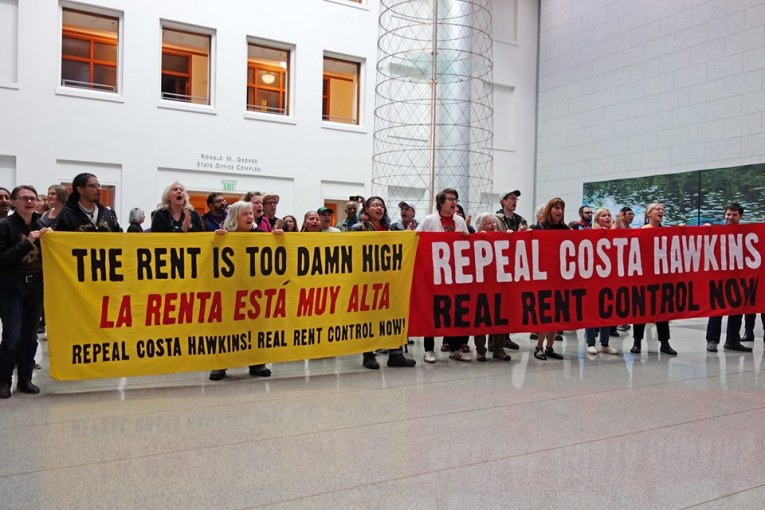

Secretary of State Alex Padilla announced on Friday that an initiative which would expand local governments’ authority to enact rent control on residential property is eligible for the November 6, 2018, ballot.
To be eligible, the initiative needed 365,880 valid petition signatures, which is equal to five percent of the total votes cast for governor in the November 2014 General Election. An initiative can qualify via random sampling of petition signatures if the sampling projects a number of valid signatures greater than 110 percent of the required number.
On June 28, 2018, the Secretary of State will certify the initiative as qualified for the November 6, 2018, ballot.
The summary of the initiative reads: “Repeals state law that currently restricts the scope of rent-control policies that cities and other local jurisdictions may impose. Allows policies that would limit the rental rates that residential-property owners may charge for new tenants, new construction, and single-family homes. In accordance with California law, provides that rent-control policies may not violate landlords’ right to a fair financial return on their rental property.”
The law will be known as: Affordable Housing Act.
The People of the State of California hereby find and declare all of the following:
a) Rents for housing have skyrocketed in recent years. Median rents are higher in California than any other state in the country, and among all 50 states, California has the 4th highest increase in  rents.
rents.
b) Research by Apartment List indicates that the median rent for a one-bedroom apartment in California is $1,410, an increase of 4.5% in just one year. A one-bedroom apartment in Los Angeles costs $1,350 per month. In San Francisco, it costs $2,450. In San Diego, the cost is $1,560.
c) The federal government has concluded that rent is not affordable if renters spend more than 30% of their income on housing costs. The State of California has found that more than half of California renter households (3 million) pay more than 30% and one-third of renter households ( over 1.5 million) pay more than 50% of their income toward rent.
d) According to the National Low Income Housing Coalition, a Californian earning minimum wage would have to work 92 hours per week in order to afford to rent an average one-bedroom apartment.
e) More Californians (5.8 million households) are renting than ever before, because overall home ownership rates in California have fallen to their lowest level since the 1940s, according to the state. One quarter of older millennials (25-34 years of age) still live with their parents. (U.S. Census Bureau)
f) Statewide labor unions, such as California Nurses Association, Service Employees International Union and the California Teachers Association, have made affordable housing a priority for their members. For example, teachers in California’s urban centers are paying 40% to 70% of their salaries on housing and many are being forced to live an hour or more from their jobs in order to afford a home.
g) Three times as many Californians are living in overcrowded apartments as compared to the U.S. as a whole. (U.S. Census Bureau)
h) Even though the state represents only 12% of the total U.S. population, California is home to 22% of the nation’s homeless population. (California Department of Housing and Community Development)
i) Homelessness is a major public health issue. People who are homeless are 3 to 4 times more likely to die prematurely and are more likely to have a communicable disease, according to the National Health Care for the Homeless Council.
j) The Centers for Disease Control and Prevention warn that vulnerable populations face lower life expectancy, higher cancer rates and more birth defects when their homes are displaced due to the gentrification of their neighborhoods.
k) The increased cost of housing is worsening traffic congestion and harming the environment by forcing commuters to live farther away from their places of employment and increasing commute times. A report by the Pew Charitable Trust noted that the number of Californians who commute more than 90 minutes each way increased by 40% between 2010 and 2015; the increase is a direct result of the dearth of affordable housing near jobs.
l) A major factor in California’s housing crisis is a 20-year-old law known as the Costa-Hawkins Rental Housing Act. Costa-Hawkins gives permission to landlords of residential apartments and houses to raise rents as much as they want in buildings built after 1995; despite local laws that would otherwise prohibit such increases, landlords in Los Angeles can raise rents as much as they want on buildings built after 1978 and in San Francisco, on buildings built after 1979.
m) Costa-Hawkins also allows a landlord to raise the rent in any building built before 1995 to the market value when it becomes vacant, and lets the landlord decide what market value is.
n) Costa-Hawkins prevents cities from implementing laws that keep rents affordable for their residents.
The People of the State of California hereby declare the following purposes and intent in enacting this Act:
a) To restore authority to California’s cities and counties to develop and implement local policies that ensure renters are able to find and afford decent housing in their jurisdictions.
b) To improve the quality of life for millions of California renters and reduce the number of Californians who face critical housing challenges and homelessness.
c) To repeal the Costa-Hawkins Rental Housing Act.
—David M. Greenwald reporting


If you read through the a through n list, most of it has nothing to do with rent control. The biggest problem we have in Davis is not rent, it’s finding a place to live. And if we were able to find a place to live, we wouldn’t have a problem with rent either.
Oh F-ing great . . .